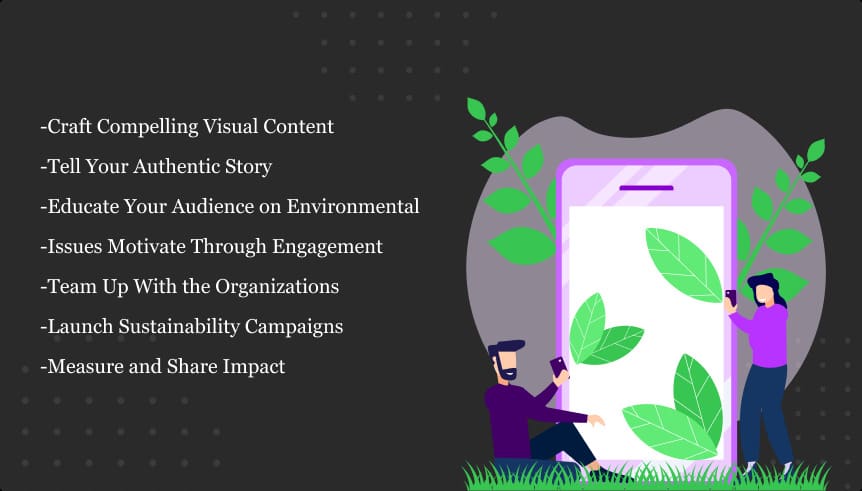People might not always be able to pinpoint the sincerity behind a brand’s message, but they can certainly sense when something doesn’t feel genuine. What consumers really want is something real. They seek something that is in line with their values and beliefs. That’s where sustainability comes in. Sustainability is not just a buzzword but rather a mindset that has the power to transform how brands present themselves online.
Today’s audiences are smart. They notice when a brand plants trees and when it’s just planting ideas for likes. The good news is that if your brand truly cares about the planet, people, and purpose, you’re already halfway into creating social media content that resonates.
In this post, we’ll dive into how, when done right, sustainability can elevate your brand’s presence and create real connection in the crowded world of social media.
Table of Contents
What is Sustainable Marketing?

Sustainable marketing is a company’s approach to promoting products or services while actively embracing and showcasing its commitment to social and environmental responsibility. Sustainable marketing is about telling a story that aligns with the values of conscious consumers. Social media sustainability refers to the responsible use of social media platforms to promote sustainable practices, showcase a brand’s environmentally friendly activities, and educate viewers about brand-related sustainability issues.
A social media marketing strategy focused on sustainability takes into account long-term impact over short-term gain. By focusing on transparency, ethical practices, and minimizing harm to the planet, businesses can distinguish themselves in a feed overflowing with messages and promotions. The goal is to build trust and loyalty with customers who care about more than just the price tag. If your brand cares about purpose and talks about it, it’s almost certain it will attract like-minded people.
Sustainability Movements on Social Media

Sustainability efforts can show up in many forms on social media. These platforms not only spread information rapidly but also shape public perception and behavior around environmental responsibility.
Here are some creative and engaging examples of how sustainability can use social media:
1. Education and Awareness
More and more, people are turning to social media as a means of learning about sustainability and bringing attention to environmental problems. Because of its transparency and informality, social media provides an excellent platform for open discussion of difficult and complex problems such as climate change.
2. Hashtag Campaigns
With the use of popular hashtags, people may interact with one another and exchange sustainability-related insights, resources, and success stories. By working together, we can raise awareness and foster a sense of belonging centered around common environmental principles.
3. Influencer Campaigns
Some brands and influencers made sustainability a central feature in their content, promoting environmentally friendly products and practices to their followers. Their widespread exposure promotes eco-friendly lifestyle choices and inspires viewers to do the same.
4. Citizen Journalism
Common people can now record and share information on environmental problems that may otherwise go unrecognized, all thanks to social media. This brings attention to critical environmental issues and gives people the capacity to hold industries and government responsible.
5. Online Petitions
Social media has made it easier for people to create and share online petitions on sustainability issues. Such activity has helped to increase awareness and put pressure on businesses and governments to act. Frequently, these petitions initiate more extensive movements, transforming online support into real-life change.
In all of these examples, social media has enabled people and brands to share their take on sustainability and position themselves as a trusted source of information, inspiration, or action.
How To Make Room for Sustainability in Your Social Media Strategy

Supporting sustainable practices doesn’t mean every post needs to be a lecture or a campaign. It’s about weaving your values into your everyday content in a way that feels natural, honest, and aligned with your brand message.
Here’s how to start making space for sustainability in your social media strategy without losing your brand’s voice:
Craft Compelling Visual Content
Attention spans are diminishing more quickly than ice at the poles. Short-form content and the speed of changing trends have made our focus shorter and our ability to engage more fleeting, forcing brands to adapt quickly to capture and hold attention.
Visual content has become the secret weapon for brands trying to break through the clutter. To grab attention is not the only goal. Social media visuals must appeal to the audience’s core beliefs, feelings, and goals. Whether it’s a powerful video, a captivating photo, or an informative infographic, every image should tell a story that resonates and feels true to your brand. Visual content creates an experience that draws people in, generating engagement and establishing a real relationship with your audience that lasts long after they make the purchase.
Tell Your Authentic Story
We’ve already established that people know the difference between genuine and fake. Well, most people can tell when a brand’s only purpose is to boost sales rather than when their intention is to create a community of like-minded followers.
Social media can do a lot for your brand if you choose to share from a place of authenticity rather than just sales. Use your SM platforms to share what your brand stands for, what drives your team, and the journey that brought you here. Talk about the wins, the lessons, and even the messy middle. When you show up with honesty, people stop scrolling, relate, and stick around.
It’s not wrong to have sales as the most important objective, but it’s wrong to create content that only speaks to one goal. We at Ginger IT encourage partners and clients to share their sustainability efforts through actions that are genuine for them.
Authentic stories don’t just connect your brand with followers; they can boost sales much more than a “buy one get one free” can. Because social media is overflowing with messages, an authentic story can easily be spotted with an honest tone, consistent voice, and a clear sense of purpose that resonates beyond the scroll.
If sustainability is part of your brand’s mission, talk about it. Share how your processes support long-term impact or what steps you’re taking to do better. Audiences don’t expect perfection – they expect honesty.
Educate Your Audience on Environmental Issues
Talking about sustainability on social media shouldn’t feel like ticking a box; it should reflect what your brand genuinely cares about. That doesn’t mean flooding your feed with statistics or preaching about what people should do.
Instead, approach it with curiosity. Share things you’re learning, highlight small changes your team is making, or spotlight other voices doing important environmental work. Some followers will appreciate practical tips; others might engage more with ethical questions or discussions with environmental experts. When your educational efforts are honest and authentic, this will position your brand as thoughtful, aware, and connected to something bigger than itself.
Motivate Through Engagement
Meaningful engagement is the first step in motivating your audience to participate in sustainability efforts.
Encourage user-generated content (UGC) by inviting followers to share their own eco-friendly habits, product swaps, or green tips using a branded hashtag. Coming up with sustainability-themed challenges or interactive polls can turn passive followers into active participants and create a sense of community. Responding to comments, sharing user posts, and asking thoughtful questions on social media show that your brand values dialogue and is genuinely invested in the cause.
When people feel heard and involved, they’re far more likely to stay engaged and inspired to take action beyond the screen.
Team Up With Environmental Organizations
Teaming up with environmental organizations can turn your Earth Day message into something much bigger than a branded post. When you work with trusted partners, whether they’re local NGOs, global movements, or eco-conscious influencers, you’re not just increasing your reach; you’re also creating credibility.
Use social media to share the story of the partnership: why it’s important, what you’re working on, and how your communities can help. It’s a chance to inspire people not just to like or share, but to believe, support, and participate in something real.
Launch Sustainability Campaigns
Make it easy for your audience to get involved by launching dedicated sustainability campaigns that spotlight your brand’s values and inspire action. Interactive campaigns such as Green Commute Week, zero-waste challenge, eco-friendly product swap, or upcycling challenge can spark real behavior change and create excitement around your brand.
Clear instructions, incentives, and regular updates will help keep followers interested and motivated throughout the campaign.
Measure and Share Impact
Something great happens when people realize their work is making a difference. Measuring and sharing results on social media will inspire your community and transform online efforts into visible change. When people see how their contributions add up, they are motivated to continue exploring the limits of what is possible, not just sustainability-wise.
Brands That Are Successfully Driving Sustainability on Social Media

By their innovative campaigns and sincere dedication, these brands are demonstrating that a commitment to sustainability can lead to creating loyal communities that believe in the cause. Using their social media platforms, these prominent brands are making a difference in the fight for sustainability.
Patagonia
Patagonia is a leader in promoting environmental sustainability through its social media channels. The brand regularly shares posts about its environmental efforts, such as using recycled materials and supporting grassroots environmental organizations. They also run campaigns like “The Footprint Chronicles,” where they show the environmental impact of their products.
Patagonia has built a strong community by authentically aligning their message with environmental activism, making sustainability a core part of their brand story.
IKEA
IKEA has made significant strides in creating a more sustainable future, and its social media reflects this commitment. With campaigns like “Sustainable Living,” IKEA educates followers about eco-friendly products, renewable energy, and their goal of becoming a circular business by 2030.
The brand is also transparent about its efforts to reduce waste and carbon emissions, making sustainability a visible part of their messaging.
Lush
In addition to producing cruelty-free, handcrafted goods, the beauty company Lush uses social media to advocate for changes in areas like fair trade and packaging waste reduction. Their posts frequently highlight their environmental initiatives, like their support for ethical ingredient sourcing and efforts to phase out plastic packaging. They also actively engage their community through a recycling initiative called the “Bring It Back” program, that encourages customers to return empty containers for recycling, reinforcing their commitment to circular sustainability.
The Bottom Line
The greatest strength of social media is its capacity to unite people in pursuit of a common goal. When your brand authentically embraces sustainability, it will start conversations, motivate people to take action, and build lasting trust. By taking steps to promote and act on sustainable initiatives across social media , you’re not just driving success—you’re building a community that cares, connects, and creates change.
